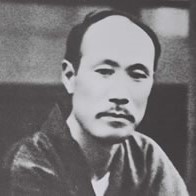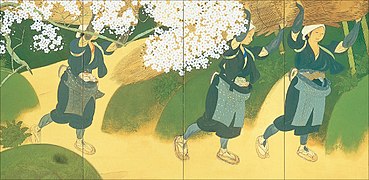Tsuchida Bakusen
Tsuchida Bakusen ( Japanese 土 田 麦 僊 ; born February 9, 1887 on the island of Sado ( Niigata prefecture ); died June 10, 1936 ; real name Kinji ( 金 二 )) was a Japanese painter of the Nihonga direction of the Taishō and early Shōwa time .
life and work
Tsuchida was born the son of a farmer. He was the older brother of the philosopher Tsuchida Kyōson (1891-1934). He was supposed to become a priest and in 1903 he was sent to the Buddhist temple Chishaku-in ( 智 積 院 ) in Kyoto . But soon he left the temple to become a painter. He first studied under Suzuki Shōnen (1848-1918), but then switched to Takeuchi Seihō . He had his first success at the second colorful exhibition (1908), where he received the 3rd prize for his painting "Punishment" ( 罰 , Batsu ). In 1909 he took (on a special course of the Municipal College of Painting Kyoto 京都市立絵画専門学校 , Kyoto Shiritsu kaiga Semmon gakko ) part, with his final work, a painting entitled "When combing" ( 髪 , Kami ), on the 5th Colorful attention.
In the further development of Tsuchida, the influence of the late Impressionists in Europe - especially Paul Gauguin - can be ascertained, as the pictures "Women of the Island" ( 島 の 女 , Shima no onna ) and "Diversinnen" ( 海 女 , Ama ) show . Dissatisfied with the painterly guidelines of the Nihonga direction, Tsuchida founded together with the painters of the same age Murakami Kagaku (1888-1939), Sakaibara Shihō (1887-1971), Irie Hakō (1887-1948) and Ono Chikkyō (1889-1979) the " National Society for Creative Painting ”( 国画 創作 協会 , Kokuga sōsaku kyōkai ) with the aim of renewing the Nihonga.
From 1921 to 1923 Tsuchida traveled through various European countries. Works from this period are “bath house women” ( 湯 女 , Yuna ), “ Maiko [dancer] in the garden” ( 舞 伎 林泉 , Bugi rinsen ) and “women of Ōhara” ( 大 原 女 , Ōhara-me ), the he showed at the exhibitions organized by his company (short form Kokuten ( 国 展 )).
In 1928, Tsuchida dissolved his company and again submitted pictures to the state-sponsored art exhibition, which has now been abbreviated to Teiten ( 帝 展 ). In 1934 he became a member of the Japanese Academy of Arts . His late works include "Poppies" ( 芥子 , Keshi ) and "Flat Bed" ( 平 牀 , Heishō ).
photos
Remarks
- ↑ Bunten ( 文 展 ) stands for Mombushō bijtsutu tenrankai ( 文部省 美術展 覧 会 ), the annual exhibition for the fine arts organized by the Ministry of Culture.
- ↑ This pair of screens appeared as a stamp pad on the occasion of the “60 Years of the National Museum of Modern Art ”, Tokyo.
- ↑ The Ōhara women brought firewood from the village of Ōhara to Kyoto and sold it there. As early as 1915, Tsuchida presented the topic on a pair of adjustable screens.
literature
- Yamada, Atsuo: Tsuchida Bakusen . Asahi Kurabu Bessatsu Nihon-hen 64, Bijutsu tokushu. 1990
- Laurance P. Roberts: Tsuchida Bakusen . In: A Dictionary of Japanese Artists. Weatherhill, 1976. ISBN 0-8348-0113-2 .
- National Museum of Modern Art, Kyoto (ed.): Tsuchida Bakusen . In: Nihonga, the Kyoto School 1910-1930. Kyoto 1986. ISBN 4-87642-117-X . (Japanese)
Web links
| personal data | |
|---|---|
| SURNAME | Tsuchida, Bakusen |
| ALTERNATIVE NAMES | 土 田 麦 僊 (Japanese, stage name); 土 田 金 二 (Japanese, real name); Tsuchida Kinji (real name) |
| BRIEF DESCRIPTION | Japanese painter |
| DATE OF BIRTH | February 9, 1887 |
| PLACE OF BIRTH | Sado Island ( Niigata Prefecture ) |
| DATE OF DEATH | June 10, 1936 |







